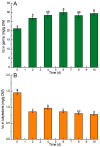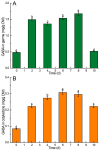Utilization of Germinated Seeds as Functional Food Ingredients: Optimization of Nutrient Composition and Antioxidant Activity Evolution Based on the Germination Characteristics of Chinese Chestnut (Castanea mollissima)
- PMID: 39200532
- PMCID: PMC11353505
- DOI: 10.3390/foods13162605
Utilization of Germinated Seeds as Functional Food Ingredients: Optimization of Nutrient Composition and Antioxidant Activity Evolution Based on the Germination Characteristics of Chinese Chestnut (Castanea mollissima)
Abstract
The current study investigated the impact of germination duration on the functional components (vitamin C, γ-aminobutyric acid (GABA), polyphenols, flavonoids) and antioxidant activity of germs and cotyledons of the germinated Chinese chestnut (Castanea mollissima). We utilized seeds of the "Zaofeng" Chinese chestnut to germinate, and sowed the seeds in wet sand at 22 °C and 85% relative humidity. The germination rate, length, diameter, and fresh weight of the sprouts were investigated at 0, 2, 4, 6, 8, and 10 days after sowing, and the kinetic changes of amylose, amylopectin, sugar components, soluble protein, vitamin C, GABA, total phenols, flavonoids, and the DPPH and ABTS free radical scavenging activity in the germs and cotyledons were monitored, respectively. The findings revealed that the germination rate and germ biomass increased continuously during germination. The germination rate reached 90% on the 8th day after sowing. Germination reduced amylose in cotyledons from 42.3% to 34.2%, amylopectin from 42.9% to 25.8%, total sugar from 12.6% to 11.4%, and vitamin C from 1.45 mg/g to 0.77 mg/g. Meanwhile, soluble protein in the embryos rose from 0.31% to 0.60%, vitamin C from 21.1 to 29.4 mg/g, GABA from 0.49 to 1.68 mg/g, total flavonoids from 53.6 to 129.7 mg/g, and ABTS antioxidant activity from 1.52 to 3.27 μmol TE/g. The average contents of D-fructose, inositol, vitamin C, GABA, polyphenols, and flavonoids and the DPPH and ABTS antioxidant activity in germs were as high as 22.5, 6, 35, 7.5, 10, 20, and 10 and 20-fold those of cotyledons, respectively. Especially, the average content of glucose in germ was as high as 80-fold that of cotyledon. D-xylulose, D-galacturonic acid, and D-ribose were only found in germs, but not in cotyledons. Considering the germ biomass and functional components content, germs of Chinese chestnuts germinated at 22 °C for 8 days are considered the most suitable raw material for functional food products. In conclusion, controlled germination not only enhances the physicochemical and functional properties of Chinese chestnut germs but also reduces the caloric content and improves the nutritional composition of the cotyledons appropriately. Moreover, the comprehensive evaluation of compositional changes and functionality in the embryo and cotyledon of Chinese chestnuts will provide a solid foundation for subsequent functional food processing utilizing germinated Chinese chestnuts.
Keywords: Castanea mollissima; antioxidant capacity; cotyledon; functional properties; germination; sprout.
Conflict of interest statement
The authors declare no conflicts of interest.
Figures







Similar articles
-
Comparative Study on Phytochemical Profiles and Antioxidant Capacities of Chestnuts Produced in Different Geographic Area in China.Antioxidants (Basel). 2020 Feb 25;9(3):190. doi: 10.3390/antiox9030190. Antioxidants (Basel). 2020. PMID: 32106518 Free PMC article.
-
Effects of GABA and Vigabatrin on the Germination of Chinese Chestnut Recalcitrant Seeds and Its Implications for Seed Dormancy and Storage.Plants (Basel). 2020 Apr 3;9(4):449. doi: 10.3390/plants9040449. Plants (Basel). 2020. PMID: 32260136 Free PMC article.
-
Transcriptomic identification and expression of starch and sucrose metabolism genes in the seeds of Chinese chestnut (Castanea mollissima).J Agric Food Chem. 2015 Jan 28;63(3):929-42. doi: 10.1021/jf505247d. Epub 2015 Jan 13. J Agric Food Chem. 2015. PMID: 25537355
-
Bioactive constituents, nutritional benefits and woody food applications of Castanea mollissima: A comprehensive review.Food Chem. 2022 Nov 1;393:133380. doi: 10.1016/j.foodchem.2022.133380. Epub 2022 Jun 3. Food Chem. 2022. PMID: 35688085 Review.
-
Total polyphenols and bioactivity of seeds and sprouts in several legumes.Curr Pharm Des. 2013;19(34):6112-24. doi: 10.2174/1381612811319340005. Curr Pharm Des. 2013. PMID: 23448441 Review.
References
-
- Yadav P.K., Bhujel P., Kafle N. Chestnut production and its prospects in Nepal. Sustain. Food. Agric. 2022;3:1–10. doi: 10.26480/sfna.01.2022.01.10. - DOI
-
- Tian G., Li Y. Lignocellulose mulch increases the economic benefit of Chinese chestnut by suppressing weed and ameliorating soil properties. Sci. Hortic. 2022;291:110576. doi: 10.1016/j.scienta.2021.110576. - DOI
-
- Abbas Y., Ahmad A. Impact of processing on nutritional and antinutritional factors of legumes: A review. Food Sci. Technol. 2018;19:199–215.
-
- Ali A.S., Elozeiri A.A. Advances in Seed Biology. In Tech Open; London, UK: 2017. Metabolic processes during seed germination; pp. 141–166.
Grants and funding
LinkOut - more resources
Full Text Sources

